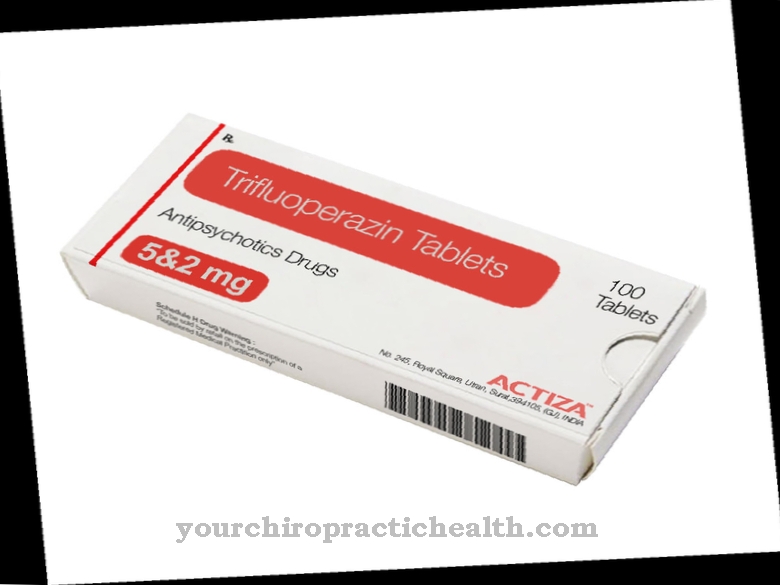Clopidogrel is a relatively new active ingredient that acts as a platelet aggregation inhibitor and has an effect on blood clotting.
As an anticoagulant, under certain conditions, clopidogrel is used in competition with the much cheaper conventional anticoagulants such as ASA (acetylsalicylic acid, aspirin), among other things, to prevent heart attacks, strokes, stent implantation and to treat peripheral occlusive disease. In principle, clopidogrel acts as an ADP receptor blocker, so that ADP-dependent platelet activation and thus platelet aggregation is inhibited.
What is clopidogrel?

Thrombocytes, also known as blood platelets, are equipped with adenosine diphosphate receptors, via which the platelet aggregation is controlled if necessary in order to e.g. B. to close injured blood vessels.
The drug clopidogrel inhibits the platelet receptors so that no or only limited platelet aggregation can occur. Clopidogrel is a thienopyridine derivative and, in its role as an anticoagulant, belongs to the group of platelet aggregation inhibitors. The drug is administered in a metabolically inactive form and, after oral ingestion, must first be converted into the bioactive form by the body through oxidation and hydrolysis.
The bioavailability after absorption in the digestive tract is about 50%. About 30% of Central Europeans are carriers of a mutated gene that reduces or completely prevents the conversion of the active ingredient into the bioactive form. The inactivation of the adenosine diphosphate receptors of the platelets is irreversible, so that the effect of the clopidogrel lasts for a few days after the drug has been discontinued until the "old" platelets are replaced by newly formed ones which is the case after about a week.
Pharmacological effect
In the presence of certain conditions or diseases such as stroke, heart attack, narrowing of the coronary arteries or peripheral arterial occlusive disease (PAD), the repair mechanism triggered by this in the form of platelet aggregation can lead to occlusion of the blood vessels with sometimes serious consequences.
In these cases, anticoagulants - also known as anticoagulants or blood thinners - are intended to reduce the tendency of the blood platelets to coagulate in order to prevent the formation of so-called thrombi (aggregation clumps) in the veins or to dissolve existing thrombi again. Since the aggregation of blood platelets is controlled by adenosine diphosphate receptors (ADP receptors), there is an option to intervene. The clopidogrel converted into the bioactive form makes the ADP receptor P2Y12 inactive by inhibiting it. The goal of reducing the tendency to develop thrombi, some of which are life-threatening, is thereby achieved. It must be taken into account that the process of inactivation or inhibition of the P2Y12 receptors is irreversible.
This means that even after the active substance clopidogrel has been broken down in the liver, the platelets cannot regain their ability to aggregate. The ability to coagulate is only restored through the process of natural platelet renewal. The life cycle of the platelets in humans is about 7 to 10 days, so that 10 days after the breakdown of the clopidogrel, a complete renewal of the blood platelets has taken place and the ability to coagulate is fully restored. B. may be important in upcoming operations.
Medical application & use
Clopidogrel is used in a large number of drugs from various manufacturers - including generics - in the form of certain salts. There are monopreparations that only contain clopidogrel as active ingredients, as well as combination products with at least one other active ingredient. Combination preparations usually contain ASA (aspirin) as the second active ingredient, which also helps prevent coagulation, but attacks at a different point in the coagulation process.
In order to achieve a rapid anticoagulant effect, a so-called loading dose of 300 to 600 milligrams is required, while the normal daily maintenance dose is 75 milligrams. If the loading dose is observed, the full effect is already achieved after two to six hours, while the full anticoagulation protection is only achieved after five to seven days without taking the loading dose. As a special feature, interactions with other anticoagulants, with certain painkillers and with so-called proton inhibitors to reduce stomach acid must be observed.
Risks & side effects
The greatest dangers associated with taking drugs containing the active ingredient clopidogrel are on the one hand that the active ingredient is not or only insufficiently converted into the bioactive form in so-called non-responders due to a known gene mutation.
As a result, the intended protection against coagulation is not achieved or is not completely achieved. If it is not known whether the patient belongs to the group of non-responders, regular use of clopidogrel may have almost no effect. After all, around 30% of people in Central Europe are affected by the mutation. Interactions with other drugs must also be considered. If additional anticoagulants are taken, the anticoagulant effect is usually increased. Interactions with antidepressants and proton inhibitors for the treatment of reflux consist in a reduction of the anticoagulant.
The other extreme is an overdose of the drug. There is no known antidote which, if accidentally overdosed, could cancel or reduce the effects of the clopidogrel. The only possibility is to infuse fluids containing platelets, however, it must be ensured that the supplied platelets are also changed as long as clopidogrel is present in the blood. The half-life for the breakdown of the clopidogrel is 7 to 8 hours. Gastrointestinal bleeding, increased nosebleeds, bruises, diarrhea and rash can occur as undesirable side effects during the treatment period.
In the event of injuries caused by an accident or a necessary emergency operation, the problem may arise that the anticoagulant achieved by clopidogrel cannot be lifted for a short time and can lead to bleeding that is difficult to stop.












.jpg)



.jpg)










.jpg)
